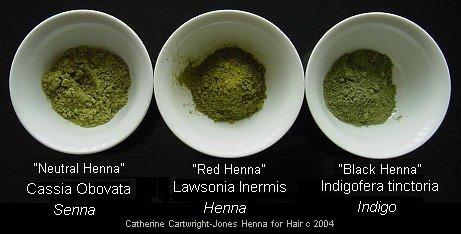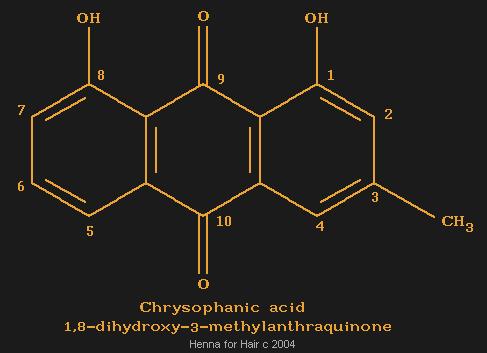|
Cassia Obovata
also known as Neutral Henna or Senna
Catherine Cartwright-Jones
Henna for Hair c
2004

If you have a box of green stuff
that says “neutral henna”, that green powder is neither neutral nor
henna. There is no such plant as neutral henna! Henna is
Lawsonia inermis, and has a red-orange dye molecule. The green
"neutral henna" powder is most likely to be Cassia obovata leaf!
Cassia obovata powder looks very
much like henna powder, but generally does not stain
hair or hands. It is an excellent conditioner which makes hair
glossy and thick, with a healthy scalp. When you mix this green
leaf powder with warm water, it has a strong smell similar to a
heap of warm mowed grass. If
your
powder stains your hair or hands yellow, it probably has some rhubarb
root mixed into it.
Cassia obovata is also known as
Senna
obovata. Cassia and Senna are used often interchangeably in botanical
texts. Do remember, though that Cassia, which is also called
Senna, is NOT the Cassia, which is true Cinnamon. Just in case
you were not confused enough already. For the purposes of this
page, I’ll refer to Cassia/Senna as Cassia.
Cassia Obovata, harvested for use in hair, is grown in Egypt and Nubia.
There are about 400 species of cassia around the world. Many of these
species are used in folk medicines, as antifungals, antibacterials and
laxatives, and were recorded in 9th and 10th century Arabic
pharmacopoeia. Several Cassias traditionally used to cure fungal
and bacterial infections have been tested and found to be highly
effective against many microbes and fungi. The antimicrobial
substance these cassias have in common is chrysophanic acid, an
anthraqinone. Rhubarb root also has chrysophanic acid.
Chysophanic acid, in its pure form is yellow, and if it is in high
concentrations in rhubarb root or cassia, it may stain hair and skin
yellow ... thus it is often used in “blonde henna” (which is not
henna, and is not blonde!)
Chrysophanic
acid (1,8-dihydroxy-3-methylanthraquinone),

Chemical
structure of chrysophanic acid
(1,8-dihydroxy-3-methylanthraquinone)
Journal of Ethnopharmacology 72
(2000) 43–46
Cassias with high levels of anthraquinones and crysophanic acid are
very effective inhibitors of skin fungus, mite infestations, bacterial
and microbial diseases. Cassia alata, which has high levels of
anthraquinones and crysophanic acid, has been traditionally used to
treat eczema, itching and skin infections in humans. It has also been
demonstrated to completely cure bovine skin lesions due to Dermatophilus Congolensis, Pityriasis versicolor,
and mite infestation
of rabbits, Psoroptes cuniculi.
In other tests, Cassia alata
anthraquinones were effective inhibitors of of Streptococus mutans, Staphylococcus aureus, Bacillus subtilis, Micrococcus luteus, and Pseudomonas putida.
Chrysophanic acid is also effective in treating
psoriasis. The cassias with high levels of anthraquinones and
crysophanic acid are genuinely effective in promoting healthy
conditions of skin and hair. Cassia obovata has not been as
throughly tested as Cassia alata, but seems to have similar properties.
Some of the early western confusion over the cassia species as used in
traditional Arabic, Indian, and North African medicines can be seen in
the 1911 edition of The British Pharmaceutical Codex, which lists Senna
Alexandrina, Alexandrian Senna; Cassia obovata; Cassia angustifolia,
Arabian senna, Mecca senna; Cassia montana; Cassia holosericea; Cassia
angustifolia, Senna Indica, Indian senna, Tinnevelly senna; Cassia
acutifolia, Cassia angustifolia and says “The constituents of senna
leaves are not yet well known.” Recent ethnobotanists have
studied these plants and attempted to clarify species, isolate and
identify phytochemicals, and test their effects on fungi and bacteria,
but still stumble around the old names. Cassia Obovata and Hard Water If
the water you use to wash your hair is full of dissolved minerals, the
minerals will accumulate in your hair. Some of those minerals may
react with the cassia and turn your hair green, dark brown, or greenish
black. Please test cassia on some hair harvested from your
hairbrush! If the color looks strange, treat your hair with
Rainwash from mehandi.com to remove the minerals before you dye your hair with cassia.
Online
references:
http://www.ibiblio.org/herbmed/eclectic/kings/cassia.html
http://www.ibiblio.org/herbmed/eclectic/kings/acidum-chry.html
http://www.ibiblio.org/herbmed/eclectic/bpc1911/cassia.html
Academic
References:
Anderson, W.A .Adedayo, O. Moo-Young, M.
Kolawole, D.O.
Antifungal Properties of Some Components of Senna Alata Flower.
Pharmaceutical Biology; Dec99, Vol. 37 Issue 5, 3 graphs
Adedayo, O.Anderson, W.A.Moo-Young, M.Snieckus, V.Patil, P.A.Kolawole,
D.O.
Phytochemistry and Antibacterial Activity of Senna alata Flower.
Pharmaceutical Biology; Dec2001, Vol. 39 Issue 6, p408, 5p, 2 charts
Adedayo, O.Anderson, W.A.Moo-Young, M. Snieckus, V.
Kinetics of Antibacterial Activity and Physicochemical Damage Caused by
the Extracts of Senna alata Flowers.
Pharmaceutical Biology; Sep2002, Vol. 40 Issue 6, p461, 5p
Agarwal , Sudhir, Singh, Sushma, Kumar
Cassia: Antifungal activity of anthraquinone derivatives from Rheum
emodi
Central Institute of Medicinal and Aromatic Plants, P.O.-CIMAP, Lucknow
226 015, India
Ali-Emmanuel, N.1Moudachirou, M.2Akakpo, J.A.3 Quetin-Leclercq, J.
Treatment of bovine dermatophilosis with Senna alata, Lantana camara
and Mitracarpus scaber leaf extracts.
Journal of Ethnopharmacology; Jun2003, Vol. 86 Issue 2/3, p167, 5p
Jittra Limsong a, E. Benjavongkulchai , Jintakorn Kuvatanasuchati
Inhibitory effect of some herbal extracts on adherence of Streptococcus
mutans
Journal of Ethnopharmacology 92, (2004), 281–289
M.R. Khan_, M. Kihara, A.D. Omoloso
Antimicrobial activity of Cassia alata
Fitoterapia, 72, 2001, 561_564
N. Mascolo, R. Capasso and F. Capasso
Senna. A Safe and Effective Drug
Phytotherapy Research, 12, S143–S145 (1998)
Menter, A. Barker, J.
Psoriasis in practice
Lancet; 7/27/91, Vol. 338 Issue 8761, p231, 4p
R. Perumal Samy, S. Ignacimuthu
Antibacterial activity of some folklore medicinal plants used by
tribals in Western Ghats of India
Journal of Ethnopharmacology, 69, (2000) 63–71
|

